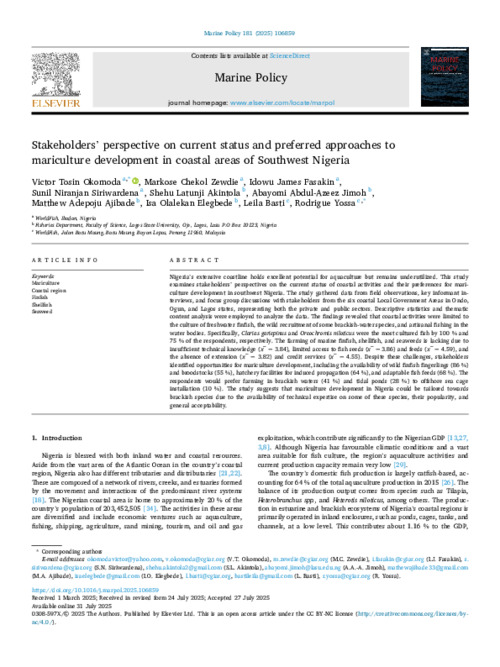Stakeholders’ perspective on current status and preferred approaches to mariculture development in coastal areas of Southwest Nigeria

Victor Okomoda, Markose Zewdie, Idowu Fasakin, Sunil Siriwardena, Shehu Akintola, Jimoh Abayomi, Matthew Ajibade, Isa Elegbede, Leila Basti, Rodrigue Yossa. (31/7/2025). Stakeholders’ perspective on current status and preferred approaches to mariculture development in coastal areas of Southwest Nigeria. Marine Policy, 181 (2025), pp. 1-9.
Nigeria’s extensive coastline holds excellent potential for aquaculture but remains underutilized. This study examines stakeholders’ perspectives on the current status of coastal activities and their preferences for mariculture development in southwest Nigeria. The study gathered data from field observations, key informant interviews, and focus group discussions with stakeholders from the six coastal Local Government Areas in Ondo, Ogun, and Lagos states, representing both the private and public sectors. Descriptive statistics and thematic content analysis were employed to analyze the data. The findings revealed that coastal activities were limited to the culture of freshwater finfish, the wild recruitment of some brackish-water species, and artisanal fishing in the water bodies. Specifically, Clarias gariepinus and Oreochromis niloticus were the most cultured fish by 100 % and 75 % of the respondents, respectively. The farming of marine finfish, shellfish, and seaweeds is lacking due to insufficient technical knowledge (x‾ = 3.84), limited access to fish seeds (x‾ = 3.86) and feeds (x‾ = 4.59), and the absence of extension (x‾ = 3.82) and credit services (x‾ = 4.55). Despite these challenges, stakeholders identified opportunities for mariculture development, including the availability of wild finfish fingerlings (86 %) and broodstocks (55 %), hatchery facilities for induced propagation (64 %), and adaptable fish feeds (68 %). The respondents would prefer farming in brackish waters (41 %) and tidal ponds (28 %) to offshore sea cage installation (10 %). The study suggests that mariculture development in Nigeria could be tailored towards brackish species due to the availability of technical expertise on some of these species, their popularity, and general acceptability.